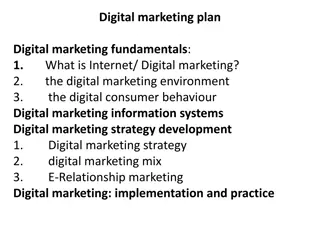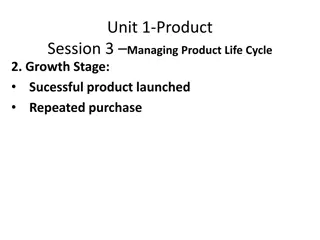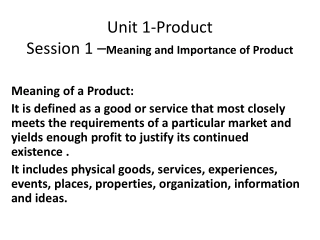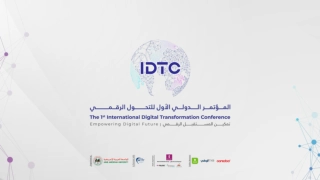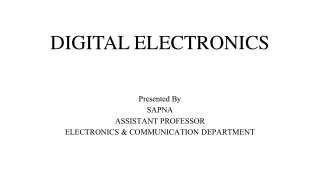
Understanding Digital Product Passport.
Explore how Digital Product Passports (DPPs) enhance transparency from production to disposal, empowering informed consumer choices. Learn about benefits like increased trust and market competitiveness, while addressing challenges such as data standardization and implementation costs. Join us to shape the future of sustainable product management with DPPs.nn
Uploaded on | 7 Views
Download Presentation
Please find below an Image/Link to download the presentation.
The content on the website is provided AS IS for your information and personal use only. It may not be sold, licensed, or shared on other websites without obtaining consent from the author. Download presentation by click this link. If you encounter any issues during the download, it is possible that the publisher has removed the file from their server.
Presentation Transcript
UNDERSTANDING DIGITAL PRODUCT PASSPORT
Introduction to Digital Product Passports Origin and Purpose of Digital Product Passports Components of a Digital Product Passport CONTENTS: Advantages of Digital Product Passports Challenges of Digital Product Passports Additional Resources Thank You
INTRODUCTION TO DIGITAL PRODUCT PASSPORTS
DIGITAL PRODUCT PASSPORT A Digital Product Passport (DPP) is like a digital document that follows a product throughout its entire life. It shows where the product comes from, what it's made of, how it's made, and its impact on the environment. DPPs help consumers make informed decisions about sustainability and encourage eco-friendly manufacturing practices.
ORIGIN Digital Product Passports (DPPs) were created to make supply chains more transparent. They developed because people became more worried about the environment. The EU's Circular Economy Action Plan played a big role in this. It aims to make products more sustainable by tracking them from start to finish. DPPs are important because they show exactly how products are made and used, helping to make sure companies are responsible.
COMPONENTS OF A DIGITAL PRODUCT PASSPORT
COMPONENTS These are the Informations that DPP contains: Product Identification and Origin Material Composition Manufacturing Process Product Specifications Usage and Maintenance Lifecycle Information End-of-Life Management Regulatory Compliance Digital and Connectivity Features Consumer Feedback and Reviews Social and Ethical Impact
ADVANTAGES OF DIGITAL PRODUCT PASSPORTS
ADVAN TAGES Enhanced Transparency:DPPs provide detailed information about a product's lifecycle, origin, and environmental impact, empowering consumers to make informed choices. Consumer Trust: By offering transparency, DPPs build trust between consumers and manufacturers, demonstrating commitment to ethical practices and sustainability. Global Standardization:DPP frameworks promote consistent product information across international markets, facilitating trade and compliance with diverse regulatory requirements.
ADVAN TAGES Regulatory Compliance: DPPs help manufacturers demonstrate adherence to environmental, safety, and quality standards, enhancing credibility and reducing regulatory risks. Market Competitiveness: Companies adopting DPPs differentiate themselves by showcasing transparency and sustainability efforts, attracting eco- conscious consumers and gaining a competitive edge.
CHALLENGES OF DIGITAL PRODUCT PASSPORTS
CHALL ENGES Data Standardization: Ensuring uniform formats and standards for DPPs across different products and industries can be challenging, affecting interoperability and data consistency. Data Privacy and Security: DPPs contain sensitive information about products, raising concerns about data protection, cybersecurity, and unauthorized access. Cost of Implementation:Developing and maintaining DPP systems can be expensive, particularly for smaller businesses with limited resources, involving technology investments and compliance with regulatory standards.
CHALL ENGES International Regulation Variations: DPPs must comply with varying data privacy laws, product standards, and sustainability regulations across different countries and regions, complicating global implementation. Consumer Awareness and Education: Many consumers are unfamiliar with DPPs and their benefits, requiring education to understand how to access and interpret the information provided, limiting their effectiveness.
ADDITIONAL RESOURCE Websites & Articles: European Commission - Circular Economy Action Plan Digital Product Passport Initiative World Economic Forum - Digital Product Passport A Comprehensive Overview by Transgenie
THANK YOU! www.transgenie.io transgenie.io@gmail.com +91 770 888 9555















